Production Designer Nathan Crowley: The Visionary Behind “Wicked’s” Stunning Sets
Before Wicked, British production designer Nathan Crowley worked on eight Christopher Nolan movies, earning six Oscar nominations along the way. Now he’s made the unlikely pivot from dark Gotham City to effervescent Emerald City as world builder-in-chief for Universal Pictures’ Wizard of Oz prequel. Based on the Broadway musical, Wicked topped the box office this past weekend with $114 million, making it Hollywood’s most popular movie musical to date. Crowley, who also designed Wonka and The Greatest Showman, marvels at the recent turn of events. “If someone said to me twenty years ago when I was working on The Dark Knight that I was going to do four movie musicals, I would have said, ‘No, I’m not.’ But it’s been a great road to go down.”
Wicked stars Cynthia Erivo and Ariana Grande as the green-skinned Elphaba and glitzily popular Glinda, respectively, who form an unlikely friendship at Shiz University before traveling to the Emerald City ruled by Jeff Goldblum’s Wonderful Wizard of Oz. Directed by Jon M. Chu (In the Heights), Wicked was shot mainly at Sky Studios Elstree in England, where Crowley oversaw a crew of up to 1,000 people
Speaking to The Credits, Crowley describes a Wicked world that includes nine million tulips, the 58-ton Emerald City Express, and an homage to Fred Astaire’s gravity-defying dance moves.
The movie basically opens on this gorgeous field of colorful flowers, leading to Munchkinland, which seems to stretch for miles and miles. How did you pull that off?
[Director] Jon [Chu] wanted Munchkinland to be practical, whimsical, and joyous, and he wanted the Munchkins to farm something, so I said, “I’m going to plant millions of tulips and give you all the colors of the rainbow.” With the help of location manager Adam Richards and a great farmer, Mark Eves, in Norfolk, to the east of England, we grew nine million tulips, going from blues to white to reds to orange. I didn’t want greens because that steps on Elphaba, and not too much yellow because then you’re stepping on. . . something else. It’s selective rainbow color choices [Laughing]. I pointed a lot, and Mark planted them.
Glinda makes a grand entrance by floating down to Munchkinland inside a translucent pink bubble. What am I looking at there?
I can’t tell you because that reveals something from the second film. but it’s more than just a bubble.
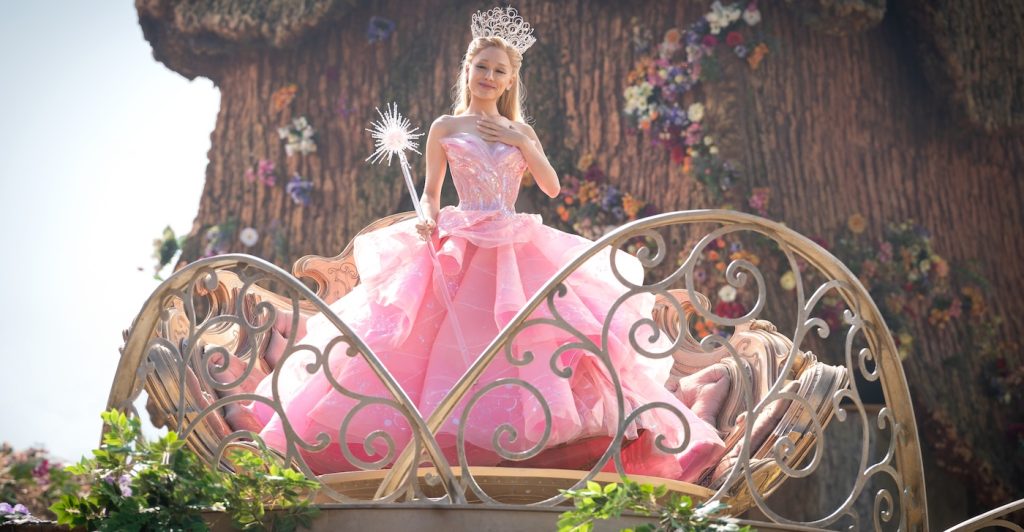
Is it physical?
The bubble is CGI. We built the machine that lowered the platform, and then the crane was removed digitally.
Munchkinland looks charming with all the little houses and their thatched roofs.
The house design was very difficult because you can fall into the traps of Middle Earth or the trap of Swiss-French villages. You wanted to build an architectural language that is familiar and something you haven’t seen before. I think the roofs do that. We were bored with the thatch, so we started spraying it different colors. It’s a blue house? Spray the thatch blue. After it soaked in, there was a sort of tint to it.
Glinda and Elphaba meet at Shiz University after arriving by boat. What influenced the look of this grand campus?
Going through that giant white arch into the lagoon, I wanted to evoke the glorious Italianesque essence of Venice mixed with Moorish architecture. And then we had onion domes for the doors.
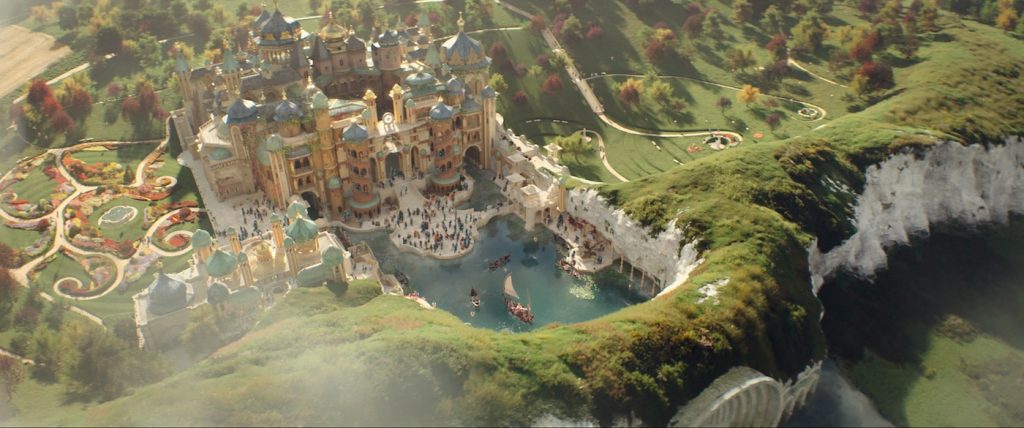
What are onion domes?
The tops of the archways are Slavic onion domes mixed with Moorish arches. Historians would be appalled [laughing]. And lastly, Wicked is an American fairy tale, so the big arch at Shiz University comes from the [Louis Sullivan] Chicago School [of architecture], decorated in this kind of Mayan way.
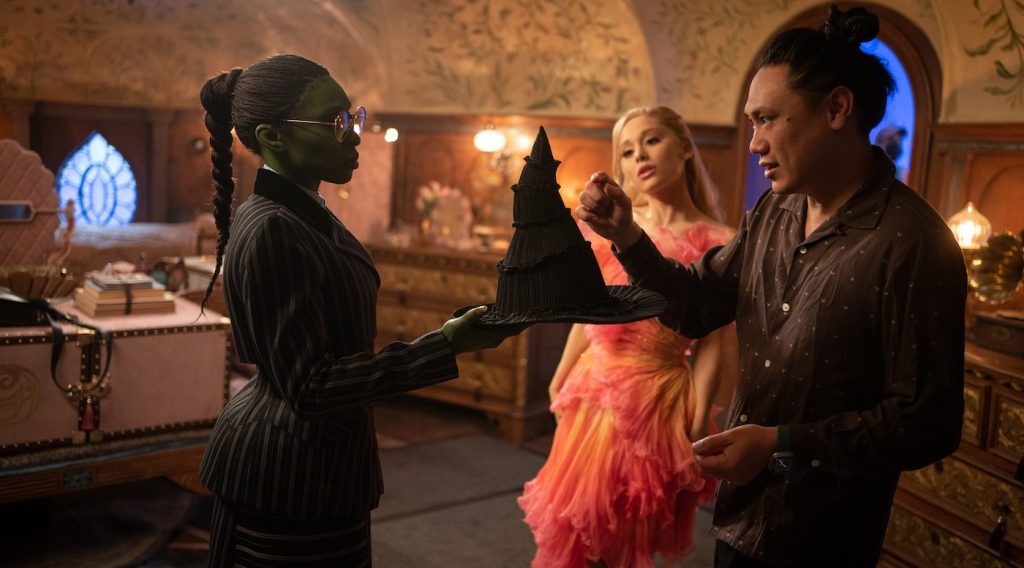
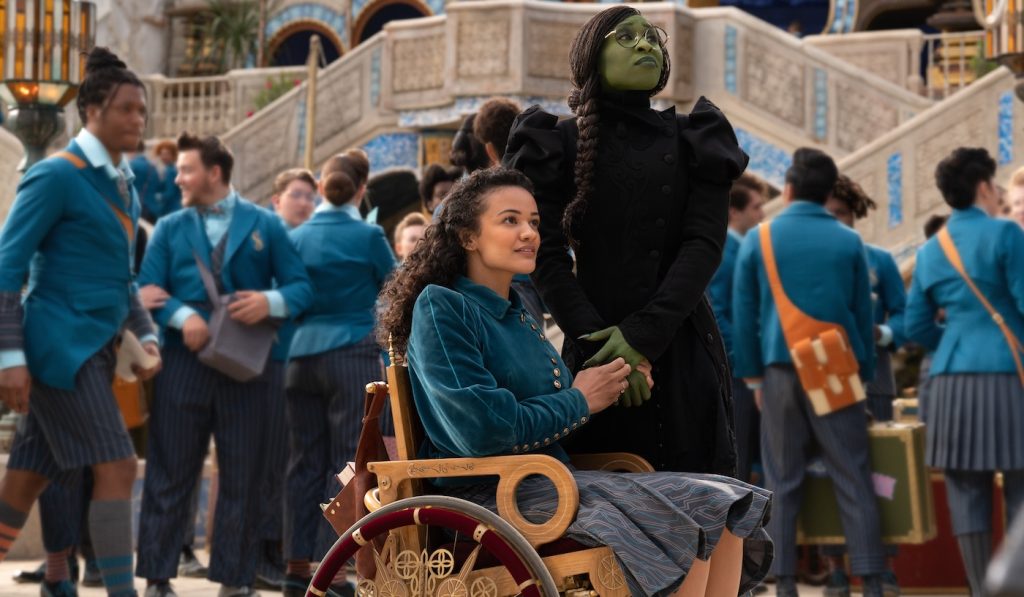
At Shiz, Glinda’s pink dorm room looks like a teenager’s fantasy suite!
I have to credit our set decorator Lee Sandales and his team who focused on every single item. We put the room on a special effects rig to get all the mirrors and dresses popping out. The amount of hydraulics under that set were phenomenal.
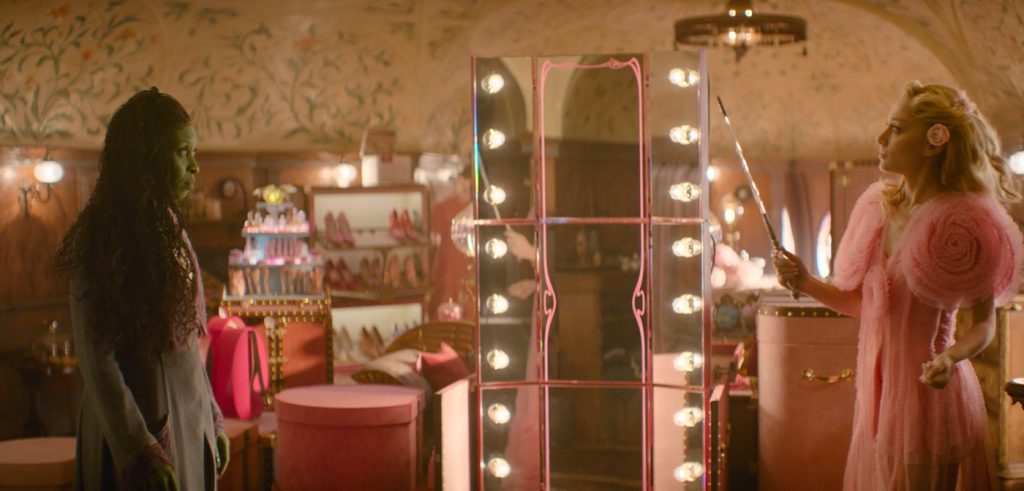
Everything in Glinda’s room is curved. Why?
The shape of the room was determined by the onion dome above it, which allowed me to make a much more interesting non-square shape with alcoves and windows that are [like] teardrops. We were able to create pockets for the beds and for the story. The onion dome allows you to break out circles within circles.
Midway through Wicked, Jonathan Bailey, as Fiyero, performs “Dance For Your Life” on curved, rotating bookshelves. Where did this wild “library” concept come from?
I loved [1951 MGM musical] Royal Wedding, where Fred Astaire dances [on the walls] in the room, proving that he can dance through the awkwardness of two [square] angles. So I said, “How about if we have wheels that move when Jonathan Bailey turns on this machine?” But I didn’t really have a decent reason for why the wheels were spinning, so Jon said, “Make them into bookshelves.”
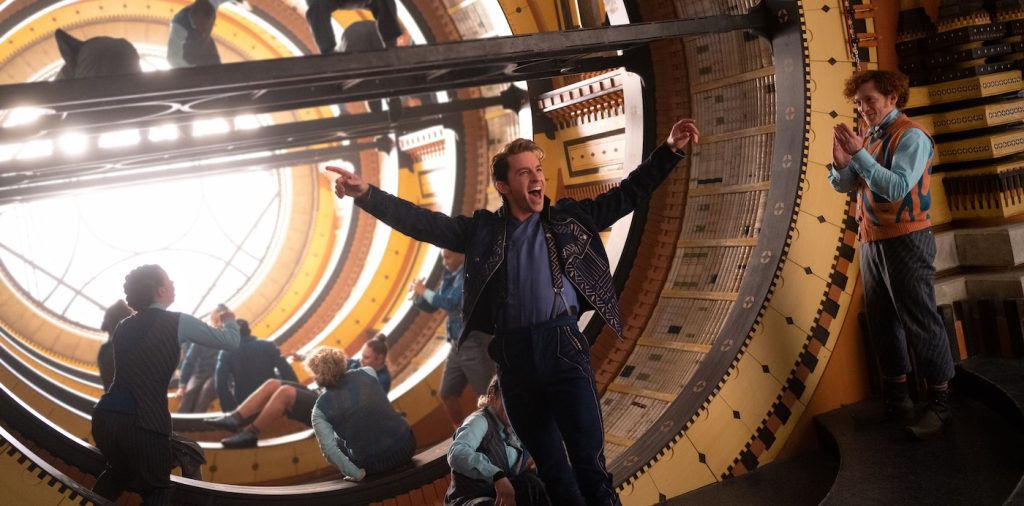
Did you build the contraption on a soundstage?
Yeah. We had circular steel drums driven by giant belts with huge mechanical wheels turning all the bookshelves and ladders. There are like six systems in there, programmed by the techs at the back. The brilliant special effects team led by Paul Corbould built the library and made the wheels work. They also built the puppeteer’s Wizard’s head with all the real expressions — no CGI there. Very few mechanical special effects teams can build rigs like that. They’re remarkable.
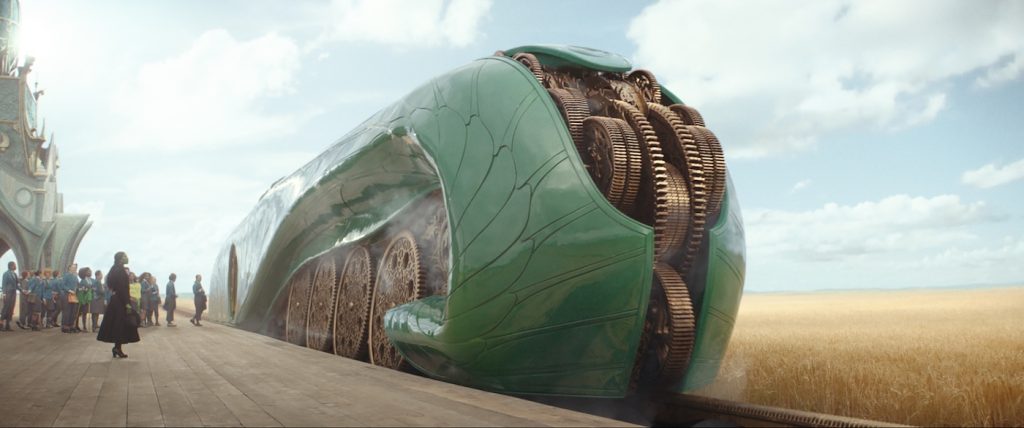
Glinda and Elphaba travel to Oz headquarters in the sleek Emerald City Express train. What did you have in mind as inspirations?
The Wizard’s train is like the old [train] carriage that [President Franklin] Roosevelt used to go around on, but the Wizard does it mechanically. It’s like a wind-up train.
What was involved in developing that sequence?
Two things: We had to build the train for real and put it in an Americana landscape, a field, like you’d see in an Andrew Wyeth painting.
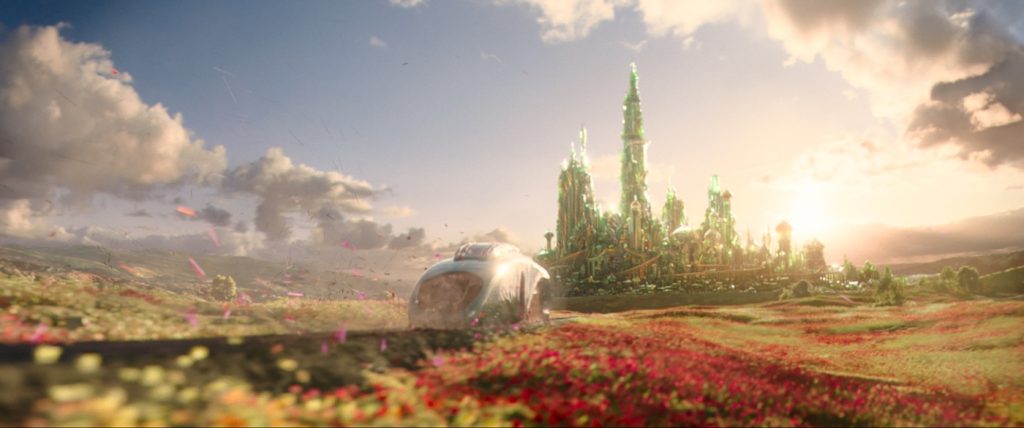
The train itself weighs 58 tons. That must have been challenging to make.
The train itself was round. We had the engine on it and we did the big wheels to move the train. Visual effects added all the little cogs, which I think is a beautiful use of VFX. We built the train sixteen feet high, the size of America’s biggest steam engine.
Emerald City looks magnificent. Inspiration?
I used the White City they built in Chicago for the 1893 [World’s Fair] Exposition because that was like a dream, and everybody went to see it.
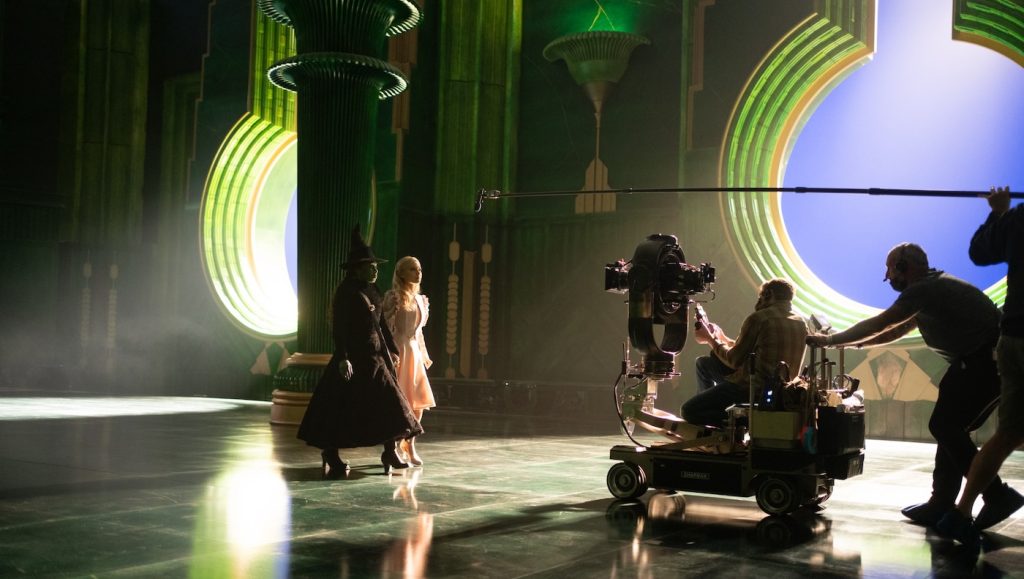
How long did the Wicked sets take to build?
I started six or seven months before we began shooting. I have to take my hat off to this army of un-thanked people — carpenters, plasterers, painters, scenic, graphics, metalworkers, sculptors, riggers — because without them, you don’t get any of this.
The impact on the local filmmaking economy must be considerable.
Absolutely. I run a core crew of about 300 people that I’ve known since The Dark Knight and who also worked with me on Wonka. On this film, we increased to 500 and then up to 1000 people because we had to get work done across three giant backlots.
With Wicked: Part Two still to come, have you been enjoying your time in the Land of Oz?
I love it. As you get older as a designer, you need to be challenged with world-building, and there’s no better place than Oz to do that.
For more on Wicked, check out these stories:
“Wicked” Cinematographer Alice Brooks on Casting a Magical Light Over This Dazzling Adaptation
“Wicked” Review Round-Up: Cynthia Erivo & Ariana Grande Dazzle in Mesmerizing Musical
Featured image: On the set of “Wicked.” Courtesy Universal Pictures.



